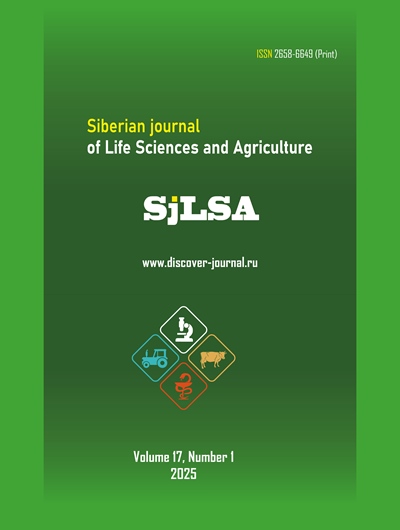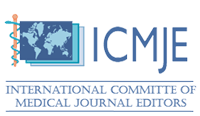Иксодовые клещи и случаи бруцеллеза в Тавушской области Армении: устойчивое сельское хозяйство
Аннотация
Обоснование. Известно, что клещи вызывают клещевые заболевания животных (метазоонозы). С другой стороны, возможными факторами риска распространения бруцеллеза на уровне животных являются пол животных и перемещения животных, взаимоотношения собака-хозяин, а также состав почвы. В настоящее время также имеются научные данные, позволяющие предположить связь между иксодовыми клещами и вспышками бруцеллеза.
Цель. Целью исследования было изучение распространенности иксодовых клещей в очагах вспышек бруцеллеза в Тавушской области Армении.
Материалы и методы. Полевые работы проводились в январе-декабре 2023 года в Тавушской области в районе Берд. Клещей собирали/определяли количественно и анализировали в соответствии со стандартными методическими указаниями. Отметки ставились с интервалом 50–60 шагов, для каждой географической зоны примерно 30 образцов.
Для создания базы данных по бруцеллезу животных с 1950 по 2020 год были изучены архивные данные профильных организаций и интернет-источников.
Результаты. В результате комплексного изучения равнинной, лесной, субальпийской и альпийской зон района Берд обнаружено шесть видов клещей: Rhipicephalus annulatus, Rhipicephalus bursa, Ixodes ricinus, Dermacentor marginatus, Hyalomma marginatum и Hyalomma scupense.
Заключение. Результаты проведенных исследований не исключают роли иксодовых клещей в вспышках бруцеллеза в регионе. Результаты важны для разработки стратегии борьбы с зоонозами, а также для определения пастбищ для скота.
EDN: FOULPV
Скачивания
Литература
References
Harutyunyan, N., Kushugulova, A., Hovhannisyan, N., & Pepoyan, A. (2022). One Health probiotics as biocontrol agents: One Health tomato probiotics. Plants, 11(10), 1334. https://doi.org/10.3390/plants11101334
Asoyan, V., Hovhannisyan, A., Mkrtchyan, A., Davidyants, M., Apresyan, H., Atoyan, L., & Niazyan, L. (2018). Evaluating the burden of brucellosis in hospitalized patients in Armenia, 2016. Online Journal of Public Health Informatics, 10(1), e62231. https://doi.org/10.5210/ojphi.v10i1.8891
Grigoryan, V. V., Abrahamyan, V. V., Kazaryan, A. S., Yeribekyan, S. V., & Grigoryan, L. H. (2023). Species composition of watch pastures in special geographical regions of Tavush Province. Biological Journal of Armenia, 75, 188–192. https://doi.org/10.54503/0366-5119-2023.75.2-3-188
Kerbabayev, E. B., & Tsuba, T. R. (2011). Ixodofauna of the Republic of Abkhazia and adjacent territories. Russian Parasitological Journal, (1), 18–26.
Manvelyan, A., Balayan, M., Miralimova, S., Chistyakov, V., & Pepoyan, A. (2023). Biofilm formation and autoaggregation abilities of novel targeted aqua-probiotics. Functional Foods in Health and Disease, 13(4), 179–190. https://doi.org/10.31989/ffhd.v13i4.1093
Mirzabekyan, S., Harutyunyan, N., Manvelyan, A., Malkhasyan, L., Balayan, M., Chistyakov, V., & Pepoyan, A. (2023). Fish probiotics: cell surface properties of fish intestinal lactobacilli and Escherichia coli. Microorganisms, 11(3), 595. https://doi.org/10.3390/microorganisms11030595
Pepoyan, A. Z., Tsaturyan, V. V., Badalyan, M., Weeks, R., Kamiya, S., & Chikindas, M. L. (2020). Blood protein polymorphisms and gut bacteria: impact of probiotic Lactobacillus acidophilus strain Narine on salmonella carriage in sheep. Beneficial Microbes, 11(2), 183–190. https://doi.org/10.3920/BM2019.0138
Pepoyan, A. Z., Balayan, M. H., Malkhasyan, L., Manvelyan, A., Bajanyan, T., Paronyan, R., & Tikomirov, N. (2019). Effects of probiotic Lactobacillus acidophilus strain INMIA 9602 Er 317/402 and putative probiotic lactobacilli on DNA damage in the small intestine of Wistar rats in vivo. Probiotics & Antimicrobial Proteins, 11(3), 905–909. https://doi.org/10.1007/s12602-018-9491-y
Pepoyan, A. Z., & Chikindas, M. L. (2019). Plant-associated and soil microbiota composition as a novel criterion for the environmental risk assessment of genetically modified plants. GM Crops & Food, 11(1), 47–53. https://doi.org/10.1080/21645698.2019.1703447
Pepoyan, A. Z., Manvelyan, A. M., Balayan, M. H., Harutyunyan, N. A., Tsaturyan, V. V., Batikyan, H., Bren, A. B., Chistyakov, V., Weeks, R., & Chikindas, M. L. (2023). Tetracycline resistance of Escherichia coli isolated from water, human stool, and fish gills from the Lake Sevan basin. Letters in Applied Microbiology, 76(2), ovad021. https://doi.org/10.1093/lambio/ovad021
Pepoyan, A. Z., Pepoyan, E. S., Galstyan, L., et al. (2021). The effect of immunobiotic/psychobiotic Lactobacillus acidophilus strain INMIA 9602 Er 317/402 Narine on gut Prevotella in familial Mediterranean fever: gender-associated effects. Probiotics & Antimicrobial Proteins, 13(5), 1306–1315. https://doi.org/10.1007/s12602-021-09779-3
Pepoyan, E., Marotta, F., Manvelyan, A., Galstyan, A., Stepanyan, L., Grigoryan, H., Grigoryan, L., Mikayelyan, M., Balayan, M., Harutyunyan, N., Mirzabekyan, S., Tsaturyan, V., Torok, T., & Pepoyan, A. (2024). Placebo-resistant gut bacteria: Akkermansia muciniphila spp. and familial Mediterranean fever disease. Frontiers in Cellular and Infection Microbiology, 14, 1336752. https://doi.org/10.3389/fcimb.2024.1336752
Pepoyan, A. Z., Manvelyan, A. M., Balayan, M. H., et al. (2020). The effectiveness of potential probiotics Lactobacillus rhamnosus Vahe and Lactobacillus delbrueckii IAHAHI in irradiated rats depends on the nutritional stage of the host. Probiotics & Antimicrobial Proteins, 12, 1439–1450. https://doi.org/10.1007/s12602-020-09662-7
Ruхyan, M., & Ohanyan, R. (2023). Effect of abiotic transformations on ixodid tick activity in mountain-forest landscapes of Armenia. Humanitarian Space. International Almanac, 12(5), 492–500. https://doi.org/10.24412/2226-0773-2023-12-5-492-500
Sargsyan, L., Davtyan, K., Hann, K., Gasparyan, S., Davidyants, V., Shekoyan, V., et al. (2019). Acute and chronic brucellosis eleven-year audit from a tertiary hospital in Armenia. The Journal of Infection in Developing Countries, 13(5.1), 42–50. https://doi.org/10.3855/jidc.10934
Serdyukov, G. V. (1956). Ixodid ticks fauna of the USSR: reference guide. Moscow: Academy of Sciences of the USSR. p. 121.
Christinovskiy, P. I. (2009). Recommendations for identifying natural foci of animal babesiosis. Russian Parasitological Journal, (1), 109–115.
Tsaturyan, V., Manvelyan, A., Balayan, M., Harutyunyan, N., Pepoyan, E., Torok, T., & Chikindas, M. (2023). Host genetics and gut microbiota composition: baseline gut microbiota composition as a possible prognostic factor for severity of COVID-19 in patients with familial Mediterranean fever disease. Frontiers in Microbiology, 14, 1107485. https://doi.org/10.3389/fmicb.2023.1107485
Tsaturyan, V., Poghosyan, A., Toczylowski, M., & Pepoyan, A. (2022). Evaluation of malondialdehyde levels, oxidative stress and host-bacteria interactions: Escherichia coli and Salmonella Derby. Cells, 11(19), 2989. https://doi.org/10.3390/cells11192989
Shevtsova, E., Vergnaud, G., Shevtsov, A., Shustov, A., Berdimuratova, K., Mukanov, K., et al. (2019). Genetic diversity of Brucella melitensis in Kazakhstan in relation to worldwide diversity. Frontiers in Microbiology, 10, 1897. https://doi.org/10.3389/fmicb.2019.01897
Abdel-Shafy, S. (2018). Is the cattle tick Rhipicephalus annulatus Say, 1821 reared on the rabbit? Journal of Parasitic Diseases, 42, 297–302. https://doi.org/10.1007/s12639-018-1000-4
Ahmed, S., Dávila, J. D., Allen, A., Haklay, M. M., Tacoli, C., & Fèvre, E. M. (2019). Does urbanization make emergence of zoonosis more likely? Evidence, myths and gaps. Environment and Urbanization, 31(2), 443–460. https://doi.org/10.1177/0956247819866124
Al Dahouk, S., Köhler, S., Occhialini, A., Jiménez de Bagüés, M. P., Hammerl, J. A., Eisenberg, T., et al. (2017). Brucella spp. of amphibians comprise genomically diverse motile strains competent for replication in macrophages and survival in mammalian hosts. Scientific Reports, 7, 44420. https://doi.org/10.1038/srep44420
Ali, S., Akhter, S., Neubauer, H., Melzer, F., Khan, I., Abatih, E. N., et al. (2017). Seroprevalence and risk factors associated with bovine brucellosis in the Potohar Plateau, Pakistan. BMC Research Notes, 10(1), 73. https://doi.org/10.1186/s13104-017-2394-2
Andreotti, R., Pérez de León, A. A., Dowd, S. E., Guerrero, F. D., Bendele, K. G., & Scoles, G. A. (2011). Assessment of bacterial diversity in the cattle tick Rhipicephalus (Boophilus) microplus through tag-encoded pyrosequencing. BMC Microbiology, 11, 6. https://doi.org/10.1186/1471-2180-11-6
Dantas-Torres, F., Latrofa, M. S., Annoscia, G., Giannelli, A., Parisi, A., & Otranto, D. (2013). Morphological and genetic diversity of Rhipicephalus sanguineus sensu lato from the New and Old Worlds. Parasites & Vectors, 6, 213. https://doi.org/10.1186/1756-3305-6-213
Elhachimi, L., Valcárcel, F., Olmeda, A. S., Elasatey, S., Khattat, S. E., & Daminet, S., et al. (2021). Rearing of Hyalomma marginatum (Acarina: Ixodidae) under laboratory conditions in Morocco. Experimental and Applied Acarology, 84(4), 785–794. https://doi.org/10.1007/s10493-021-00641-3
Federal Center for Hygiene and Epidemiology of Rospotrebnadzor. Collection, registration, and preparation for laboratory research of blood-sucking arthropods in natural foci of dangerous infectious diseases: Guidelines. Moscow, 2011, 55 p.
González-Espinoza, G., Arce-Gorvel, V., Mémet, S., & Gorvel, J. P. (2021). Brucella: reservoirs and niches in animals and humans. Pathogens, 10(2), 186. https://doi.org/10.3390/pathogens10020186
Grech-Angelini, S., Stachurski, F., Lancelot, R., Boissier, J., Allienne, J. F., Gharbi, M., & Uilenberg, G. (2016). First report of the tick Hyalomma scupense (natural vector of bovine tropical theileriosis) on the French Mediterranean island of Corsica. Veterinary Parasitology, 216, 33–37. https://doi.org/10.1016/j.vetpar.2015.11.015
Huy, T. X., Reyes, A. W., Hop, H. T., Arayan, L. T., Min, W., & Lee, H. J., et al. (2017). Intracellular trafficking modulation by ginsenoside Rg3 inhibits Brucella abortus uptake and intracellular survival within RAW 264.7 cells. Journal of Microbiology and Biotechnology, 27(3), 616–623. https://doi.org/10.4014/jmb.1609.09060
Jamil, T., Melzer, F., Khan, I., Iqbal, M., Saqib, M., Hammad Hussain, M., et al. (2019). Serological and molecular investigation of Brucella species in dogs in Pakistan. Pathogens, 8(4), 294. https://doi.org/10.3390/pathogens8040294
Kapo, N., Zuber Bogdanović, I., Gagović, E., Žekić, M., & Veinović, G. (2024). Ixodid ticks and zoonotic tick-borne pathogens of the Western Balkans. Parasites & Vectors, 17(1), 45. https://doi.org/10.1186/s13071-023-06116-1
Ma, R., Li, C., Gao, A., et al. (2024). Evidence-practice gap analysis in the role of ticks in brucellosis transmission: a scoping review. Infectious Diseases of Poverty, 13, 3. https://doi.org/10.1186/s40249-023-01170-4
Matei, I. A., Ionică, A. M., Corduneanu, A., Domșa, C., & Sándor, A. D. (2021). The presence of Ehrlichia canis in Rhipicephalus bursa ticks collected from ungulates in Continental Eastern Europe. Journal of Veterinary Research, 65, 271–275. https://doi.org/10.2478/jvetres-2021-0044
Mendoza-Roldan, J. A., Mendoza-Roldan, M. A., & Otranto, D. (2021). Reptile vector-borne diseases of zoonotic concern. International Journal for Parasitology: Parasites and Wildlife, 15, 132–142. https://doi.org/10.1016/j.ijppaw.2021.04.007
Scholz, H., Hubalek, Z., Nesvadbova, J., Tomaso, H., Vergnaud, G., Le Flèche, et al. (2008). Isolation of Brucella microti from soil. Emerging Infectious Diseases, 14(8), 1316–1317. https://doi.org/10.3201/eid1408.080286
Springer, A., Glass, A., Topp, A. K., & Strube, C. (2020). Zoonotic tick-borne pathogens in temperate and cold regions of Europe—a review on the prevalence in domestic animals. Frontiers in Veterinary Science, 10, 604910. https://doi.org/10.3389/fvets.2020.604910
Statistical Committee of the Republic of Armenia. (2022). Social-demographic sector. Retrieved from https://armstat.am/file/article/sv_04_22r_590.pdf
Wang, H., Hoffman, C., Yang, X., Clapp, B., & Pascual, D. W. (2020). Targeting resident memory T-cell immunity culminates in pulmonary and systemic protection against Brucella infection. PLoS Pathogens, 16(1), e1008176. https://doi.org/10.1371/journal.ppat.1008176
Zhang, F., Li, Z., Jia, B., Zhu, Y., Pang, P., Zhang, C., & Ding, J. (2019). The immunogenicity of OMP31 peptides and its protection against Brucella melitensis infection in mice. Scientific Reports, 9(1), 3512. https://doi.org/10.1038/s41598-019-40084-w
Список литературы
Harutyunyan, N., Kushugulova, A., Hovhannisyan, N., & Pepoyan, A. (2022). One Health Probiotics as Biocontrol Agents: One Health Tomato Probiotics. Plants, 11(10), 1334. https://doi.org/10.3390/plants11101334
Asoyan, V., Hovhannisyan, A., Mkrtchyan, A., Davidyants, M., Apresyan, H., Atoyan, L., & Niazyan, L. (2018). Evaluating the Burden of Brucellosis in Hospitalized Patients in Armenia, 2016. Online Journal of Public Health Informatics, 10(1), e62231. https://doi.org/10.5210/ojphi.v10i1.8891
Григорян, В. В., Абраамян, В. В., Казарян, А. С., Ерибекян, С. В., & Григорян, Л. Х. (2023). Видовой состав вахтовых пастбищ в особых географических регионах Тавушской области. Биологический журнал Армении, 75, 188–192. https://doi.org/10.54503/0366-5119-2023.75.2-3-188
Кербабаев, Э. Б., & Цуба, Т. Р. (2011). Иксодофауна Республики Абхазия и сопредельных территорий. Российский паразитологический журнал, (1), 18–26.
Manvelyan, A., Balayan, M., Miralimova, S., Chistyakov, V., & Pepoyan, A. (2023). Biofilm Formation and Auto-Aggregation Abilities of Novel Targeted Aqua-Probiotics. Functional Foods in Health and Disease, 13(4), 179–190. https://doi.org/10.31989/ffhd.v13i4.1093
Mirzabekyan, S., Harutyunyan, N., Manvelyan, A., Malkhasyan, L., Balayan, M., Chistyakov, V., & Pepoyan, A. (2023). Fish Probiotics: Cell Surface Properties of Fish Intestinal Lactobacilli and Escherichia coli. Microorganisms, 11(3), 595. https://doi.org/10.3390/microorganisms11030595
Pepoyan, A. Z., Tsaturyan, V. V., Badalyan, M., Weeks, R., Kamiya, S., & Chikindas, M. L. (2020). Blood Protein Polymorphisms and the Gut Bacteria: Impact of Probiotic Lactobacillus acidophilus Narine on Salmonella Carriage in Sheep. Beneficial Microbes, 11(2), 183–190. https://doi.org/10.3920/BM2019.0138
Pepoyan, A. Z., Balayan, M. H., Malkhasyan, L., Manvelyan, A., Bajanyan, T., Paronyan, R., & Tikomirov, N. (2019). Effects of Probiotic Lactobacillus acidophilus Strain INMIA 9602 Er 317/402 and Putative Probiotic Lactobacilli on DNA Damage in the Small Intestine of Wistar Rats In Vivo. Probiotics & Antimicrobial Proteins, 11(3), 905–909. https://doi.org/10.1007/s12602-018-9491-y
Pepoyan, A. Z., & Chikindas, M. L. (2019). Plant-Associated and Soil Microbiota Composition as a Novel Criterion for the Environmental Risk Assessment of Genetically Modified Plants. GM Crops & Food, 11(1), 47–53. https://doi.org/10.1080/21645698.2019.1703447
Pepoyan, A. Z., Manvelyan, A. M., Balayan, M. H., Harutyunyan, N. A., Tsaturyan, V. V., Batikyan, H., Bren, A. B., Chistyakov, V., Weeks, R., & Chikindas, M. L. (2023). Tetracycline Resistance of Escherichia Coli Isolated From Water, Human Stool, and Fish Gills From the Lake Sevan Basin. Letters in Applied Microbiology, 76(2), ovad021. https://doi.org/10.1093/lambio/ovad021
Pepoyan, A. Z., Pepoyan, E. S., Galstyan, L., et al. (2021). The Effect of Immunobiotic/Psychobiotic Lactobacillus Acidophilus Strain INMIA 9602 Er 317/402 Narine on Gut Prevotella in Familial Mediterranean Fever: Gender-Associated Effects. Probiotics & Antimicrobial Proteins, 13(5), 1306–1315. https://doi.org/10.1007/s12602-021-09779-3
Pepoyan, E., Marotta, F., Manvelyan, A., Galstyan, A., Stepanyan, L., Grigoryan, H., Grigoryan, L., Mikayelyan, M., Balayan, M., Harutyunyan, N., Mirzabekyan, S., Tsaturyan, V., Torok, T., & Pepoyan, A. (2024). Placebo-Resistant Gut Bacteria: Akkermansia muciniphila spp. and Familial Mediterranean Fever Disease. Frontiers in Cellular and Infection Microbiology, 14, 1336752. https://doi.org/10.3389/fcimb.2024.1336752
Pepoyan, A. Z., Manvelyan, A. M., Balayan, M. H., et al. (2020). The Effectiveness of Potential Probiotics Lactobacillus Rhamnosus Vahe and Lactobacillus Delbrueckii IAHAHI in Irradiated Rats Depends on the Nutritional Stage of the Host. Probiotics & Antimicrobial Proteins, 12, 1439–1450. https://doi.org/10.1007/s12602-020-09662-7
Рухян, М., & Оганесян, Р. (2023). Влияние абиотических преобразований на активность иксодовых клещей в горно-лесных ландшафтах Армении. Гуманитарное пространство. Международный альманах, 12(5), 492–500. https://doi.org/10.24412/2226-0773-2023-12-5-492-500
Sargsyan, L., Davtyan, K., Hann, K., Gasparyan, S., Davidyants, V., Shekoyan, V., et al. (2019). Acute and Chronic Brucellosis Eleven-Year Audit from a Tertiary Hospital in Armenia. The Journal of Infection in Developing Countries, 13(5.1), 42–50. https://doi.org/10.3855/jidc.10934
Сердюков, Г. В. (1956). Иксодовые клещи фауны СССР: справочник. Москва: Академия наук СССР. С. 121.
Христиновский, П. И. (2009). Рекомендации по выявлению природных очагов пироплазмоза животных. Российский паразитологический журнал, (1), 109–115.
Tsaturyan, V., Manvelyan, A., Balayan, M., Harutyunyan, N., Pepoyan, E., Torok, T., & Chikindas, M. (2023). Host Genetics and Gut Microbiota Composition: Baseline Gut Microbiota Composition as a Possible Prognostic Factor for the Severity of COVID-19 in Patients With Familial Mediterranean Fever Disease. Frontiers in Microbiology, 14, 1107485. https://doi.org/10.3389/fmicb.2023.1107485
Tsaturyan, V., Poghosyan, A., Toczylowski, M., & Pepoyan, A. (2022). Evaluation of Malondialdehyde Levels, Oxidative Stress and Host-Bacteria Interactions: Escherichia coli and Salmonella Derby. Cells, 11(19), 2989. https://doi.org/10.3390/cells11192989
Shevtsova, E., Vergnaud, G., Shevtsov, A., Shustov, A., Berdimuratova, K., Mukanov, K., et al. (2019). Genetic Diversity of Brucella Melitensis in Kazakhstan in Relation to Worldwide Diversity. Frontiers in Microbiology, 10, 1897. https://doi.org/10.3389/fmicb.2019.01897
Abdel-Shafy, S. (2018). Is the cattle tick Rhipicephalus annulatus Say, 1821 reared on the rabbit? Journal of Parasitic Diseases, 42, 297–302. https://doi.org/10.1007/s12639-018-1000-4
Ahmed, S., Dávila, J. D., Allen, A., Haklay, M. M., Tacoli, C., & Fèvre, E. M. (2019). Does urbanization make emergence of zoonosis more likely? Evidence, myths and gaps. Environment and Urbanization, 31(2), 443–460. https://doi.org/10.1177/0956247819866124
Al Dahouk, S., Köhler, S., Occhialini, A., Jiménez de Bagüés, M. P., Hammerl, J. A., Eisenberg, T., et al. (2017). Brucella spp. of amphibians comprise genomically diverse motile strains competent for replication in macrophages and survival in mammalian hosts. Scientific Reports, 7, 44420. https://doi.org/10.1038/srep44420
Ali, S., Akhter, S., Neubauer, H., Melzer, F., Khan, I., Abatih, E. N., et al. (2017). Seroprevalence and risk factors associated with bovine brucellosis in the Potohar Plateau, Pakistan. BMC Research Notes, 10(1), 73. https://doi.org/10.1186/s13104-017-2394-2
Andreotti, R., Pérez de León, A. A., Dowd, S. E., Guerrero, F. D., Bendele, K. G., & Scoles, G. A. (2011). Assessment of bacterial diversity in the cattle tick Rhipicephalus (Boophilus) microplus through tag-encoded pyrosequencing. BMC Microbiology, 11, 6. https://doi.org/10.1186/1471-2180-11-6
Dantas-Torres, F., Latrofa, M. S., Annoscia, G., Giannelli, A., Parisi, A., & Otranto, D. (2013). Morphological and genetic diversity of Rhipicephalus sanguineus sensu lato from the New and Old Worlds. Parasites & Vectors, 6, 213. https://doi.org/10.1186/1756-3305-6-213
Elhachimi, L., Valcárcel, F., Olmeda, A. S., Elasatey, S., Khattat, S. E., & Daminet, S., et al. (2021). Rearing of Hyalomma marginatum (Acarina: Ixodidae) under laboratory conditions in Morocco. Experimental and Applied Acarology, 84(4), 785–794. https://doi.org/10.1007/s10493-021-00641-3
Сбор, учет и подготовка к лабораторному исследованию кровососущ их членистоногих в природных очагах опасных инфекционных болезней: Методические указания. М.: Федеральный центр гигиены и эпидемиологии Роспотребнадзора, 2011. 55 с.
González-Espinoza, G., Arce-Gorvel, V., Mémet, S., & Gorvel, J. P. (2021). Brucella: reservoirs and niches in animals and humans. Pathogens, 10(2), 186. https://doi.org/10.3390/pathogens10020186
Grech-Angelini, S., Stachurski, F., Lancelot, R., Boissier, J., Allienne, J. F., Gharbi, M., & Uilenberg, G. (2016). First report of the tick Hyalomma scupense (natural vector of bovine tropical theileriosis) on the French Mediterranean island of Corsica. Veterinary Parasitology, 216, 33–37. https://doi.org/10.1016/j.vetpar.2015.11.015
Huy, T. X., Reyes, A. W., Hop, H. T., Arayan, L. T., Min, W., & Lee, H. J., et al. (2017). Intracellular trafficking modulation by ginsenoside Rg3 inhibits Brucella abortus uptake and intracellular survival within RAW 264.7 cells. Journal of Microbiology and Biotechnology, 27(3), 616–623. https://doi.org/10.4014/jmb.1609.09060
Jamil, T., Melzer, F., Khan, I., Iqbal, M., Saqib, M., Hammad Hussain, M., et al. (2019). Serological and molecular investigation of Brucella species in dogs in Pakistan. Pathogens, 8(4), 294. https://doi.org/10.3390/pathogens8040294
Kapo, N., Zuber Bogdanović, I., Gagović, E., Žekić, M., & Veinović, G. (2024). Ixodid ticks and zoonotic tick-borne pathogens of the Western Balkans. Parasites & Vectors, 17(1), 45. https://doi.org/10.1186/s13071-023-06116-1
Ma, R., Li, C., Gao, A., et al. (2024). Evidence-practice gap analysis in the role of ticks in brucellosis transmission: a scoping review. Infectious Diseases of Poverty, 13, 3. https://doi.org/10.1186/s40249-023-01170-4
Matei, I. A., Ionică, A. M., Corduneanu, A., Domșa, C., & Sándor, A. D. (2021). The presence of Ehrlichia canis in Rhipicephalus bursa ticks collected from ungulates in Continental Eastern Europe. Journal of Veterinary Research, 65, 271–275. https://doi.org/10.2478/jvetres-2021-0044
Mendoza-Roldan, J. A., Mendoza-Roldan, M. A., & Otranto, D. (2021). Reptile vector-borne diseases of zoonotic concern. International Journal for Parasitology: Parasites and Wildlife, 15, 132–142. https://doi.org/10.1016/j.ijppaw.2021.04.007
Scholz, H., Hubalek, Z., Nesvadbova, J., Tomaso, H., Vergnaud, G., Le Flèche, et al. (2008). Isolation of Brucella microti from soil. Emerging Infectious Diseases, 14(8), 1316–1317. https://doi.org/10.3201/eid1408.080286
Springer, A., Glass, A., Topp, A. K., & Strube, C. (2020). Zoonotic tick-borne pathogens in temperate and cold regions of Europe—a review on the prevalence in domestic animals. Frontiers in Veterinary Science, 10, 604910. https://doi.org/10.3389/fvets.2020.604910
Statistical Committee of the Republic of Armenia. (2022). Social-demographic sector. Retrieved from https://armstat.am/file/article/sv_04_22r_590.pdf
Wang, H., Hoffman, C., Yang, X., Clapp, B., & Pascual, D. W. (2020). Targeting resident memory T-cell immunity culminates in pulmonary and systemic protection against Brucella infection. PLoS Pathogens, 16(1), e1008176. https://doi.org/10.1371/journal.ppat.1008176
Zhang, F., Li, Z., Jia, B., Zhu, Y., Pang, P., Zhang, C., & Ding, J. (2019). The immunogenicity of OMP31 peptides and its protection against Brucella melitensis infection in mice. Scientific Reports, 9(1), 3512. https://doi.org/10.1038/s41598-019-40084-w
Просмотров аннотации: 331 Загрузок PDF: 9
Copyright (c) 2025 Valery V. Grigoryan, Hrachya S. Tspnetsyan, Liana H. Grigoryan, Viktor V. Abrahamyan, Spartak V. Yeribekyan, Gayane M. Petrosyan, Astghik Z. Pepoyan

Это произведение доступно по лицензии Creative Commons «Attribution-NonCommercial-NoDerivatives» («Атрибуция — Некоммерческое использование — Без производных произведений») 4.0 Всемирная.






















































